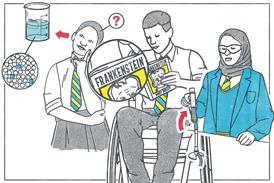Emily Seeber recommends adapting practical work to help students link experiments to theory and retain what they learn

It is time to think critically about how best to teach practical work. This is particularly the case for those teaching A-level courses now that assessed practicals have gone, and now we know the rules of engagement for required practicals. The explicit focus on practical skills within written exams means students need a deep understanding of the underlying chemistry as well the practical.
I have been developing a practical curriculum with students’ understanding of practical method and links to theory at its heart. The approach is completely different to the way we used to prepare students for assessed practicals. Under that system, designing practicals as similar as possible to the ‘real thing’ meant students could simply repeat themselves under timed conditions. This, however, lacks emphasis on understanding.
To design a coherent practical course focused on student learning rather than performance, I advocate three key principles that mean ripping up the materials provided by exam boards, designing better ones, and putting the burden of effort squarely onto students’ shoulders – they can handle it.
1. Balance content and practical skills with a range of activities
Consider what additional practical work would support students’ learning. Within each A-level curriculum topic, there tends to be just one practical required by exam boards. However, this shouldn’t be the only practical your students carry out in each topic.
For ideas about practical content you can use as part of teaching a topic, identify practicals in exam papers that differ to the required one. For example, not all moles questions are based on straightforward titrations, so why stick to titrations?
Identify skills a required practical focuses on, and create more opportunities to develop those skills. For example, if a required practical emphasises quantitative data analysis, then supporting practicals beforehand should focus students on planning, assessment of risk, or processing qualitative data. Without this shift of perspective, students only gain surface learning of the underlying ideas.
As an example, you could carry out the following sequence of practicals to balance learning energetics with learning data analysis skills:
| Practical | Focus on | |
|---|---|---|
| Supporting |
Determining the enthalpy of combustion of alcohols |
Identifying and evaluating errors |
|
Determining the enthalpy of reaction between zinc and copper sulfate |
Data analysis – plotting graphs/using data loggers and data software |
|
|
Using Hess’s law to determine the enthalpy of oxidation of magnesium |
Data analysis – designing and using the Hess cycle |
|
| Core |
Using Hess’s law to determine the enthalpy of decomposition of KHCO3 |
Designing a practical method |
2. Adapt practicals to link observations and ideas
To really get students thinking, don’t be afraid to adapt practical sheets provided by exam boards to match students’ needs. All sheets give the full method, safety and analysis questions, which undermine students’ opportunities to show they have attained the common practical assessment criteria.
There are a number of quick ways to edit the practical sheets.
- Delete the method so students can fill it in themselves.
- Edit the method so it contains mistakes for students to correct.
- Give students a range of apparatus to select from.
- Provide the method, but ask students to determine the analysis they will carry out.
- Give students chemical hazard information and get them to fill in the safety information.
Deeper learning results when students link their experimental observations to their theoretical understanding. Use the framework below during department meetings to discuss, evaluate and improve a required practical. You will all benefit from a range of ideas and responses.
| Likely outcomes of the practical | In the domain of observables | In the domain of ideas |
|---|---|---|
| What will students do? |
What are the practical skills students will use? Will students design the method/draw a graph/complete calculations/draw conclusions/evaluate the method? Will students ask for a lot of teacher support during the practical? If so, how could we clarify the instructions? |
What are the key ideas the students will think about? Do these ideas match the intended ideas? How could we adapt the practical to ensure students are thinking about the intended ideas? |
| What will students learn? |
What are the observations/patterns/data that students will gain from the practical? What practical skills will students learn by doing the practical? |
Could students develop any misconceptions from the practical? If so, how could we adapt the practical to minimise this risk? Are students directed to link their findings to the key ideas? How will we know if a student has successfully linked their findings to the key ideas? |
3. Make students do the difficult bits
Get students to do the thinking teachers usually do before a lesson, ie which concentration of acid should I order for this titration, or what is the maximum temperature for this rates practical? When I plan practical work for students, I deprive students of the opportunity – yes, the opportunity – of doing that for themselves.
Run practical pre-labs, as ‘real’ scientists would do. Give students the wrong concentration so they have to work out the right dilution from a few rough titrations. Let them do some trials instead of telling them what concentrations of peroxodisulfate get reasonable times in a clock reaction.
Download this adapted required practical (MS Word or pdf) that asks students to design a rates experiment to determine activation energy. Students must do some preliminary tests to work out what they might see and why first of all. Students find this sense of agency empowering, and the level of answers they can give about the practical is much more sophisticated.
Downloads
Determine reaction activation energy: worksheet
Word, Size 55.17 kbDetermine reaction activation energy: worksheet
PDF, Size 0.61 mb














No comments yet